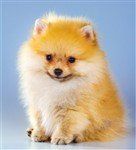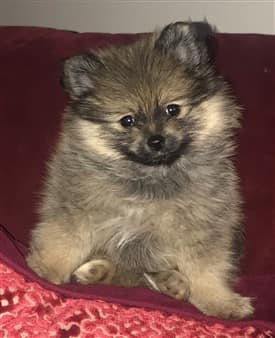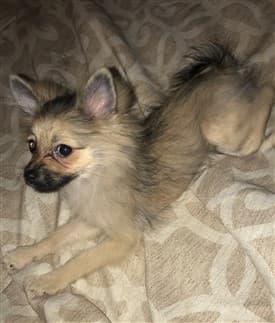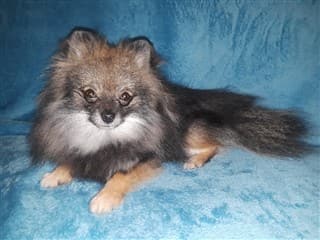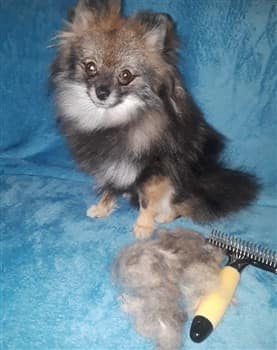Pomeranian Shedding Information
Overview
There are two types of Pomeranian shedding. Pomeranian puppies go through a phase called the puppy uglies in which the soft and short puppy coat sheds off and is replaced by the adult coat. And adult Pomeranian dogs have moderate shedding year-round and 1 or 2 seasonal sheds.
Please note:
PetPom is reader-supported, and some of the product suggestions on this page are affiliate links. As an Amazon Associate we earn from qualifying purchases. This is at no extra cost to you and helps us continue providing free, high-quality information.
Pomeranian Puppy Shedding
What to know:
Young Pomeranian puppies have a single coat of very soft and rather short puppy fur. All Pom pups enter a phase of relatively fast transition in which the puppy coat sheds off and is replaced by the adult coat. The adult coat (which goes through its own type of shedding; more ahead) is comprised of a very dense undercoat and an outer coat of longer guard hairs.
A Pomeranian puppy starts to shed off their puppy coat around the age of 4 to 6 months. For many (but not all) Pomeranians, the puppy coat sheds away much faster than the adult coat can fill in. So for a short time, fur may look very patchy and uneven. Sections may be sparse and thin. Some areas may even become nearly bald. Because this can make a Pomeranian puppy look odd for a short time, this phase is often referred to as the puppy uglies.
By the age of about 10 months old, you'll notice that the adult fur is now starting to fill in nicely on your Pomeranian puppy
and by the 12 to 15-month mark, the adult coat should be fully grown in.
You'll certainly notice a big difference in the look and feel of the adult coat. The outer layer of guard hairs are notably longer than the puppy coat was. And the baby soft fur will be replaced with more textured fur. If you follow coat care guidelines, the coat will still be soft and feel nice to the touch, but it will be noticeably thicker and have more substance to it.
Interestingly, the color of the fur can change quite drastically during this time as well. For example, a black Pom with a touch of brown can end up with a chocolate brown coat or a Pom puppy that is white with a touch of brindle can loose all the brindle and end up with a dark, cream coat.
Photo Examples:
Photos of Bailee are courtesy of Britanee Gugel
Adult Pomeranian Shedding FAQ
Once you and your Pom get through the sometimes dramatic phase of the puppy coat shedding off, you may want to breath a sigh of relief. But keep in mind that your now adult Pomeranian is still going to shed, albeit in a different way. Let's dive into some FAQ.
Do Pomeranians shed?
Yes, they are considered to be moderate shedders.
When does a Pomeranian shed?
All Pomeranians have light shedding year-round. Much like human hair, the coat is always in a process of renewal. Fur grows, rests (pauses) and falls out on a continual basis. Most Poms also 1 or 2 noticeable seasonal sheds (see next).
Does a Pomeranian have seasonal sheds or times of heavy shedding?
Yes, many do. This is also known as 'blowing the coat' since a significant amount of fur can shed off. These shedding cycles are triggered by changes in daylight hours and by changes in temperature.
For those that live in an area that experiences four seasons, there may be heavy shedding twice per year, once in autumn and then again in the spring, or just one major shed in the spring or early summer.
For those that live in warmer climates where it stays relatively mild in the winter and closer to the equator where there is more winter sunlight hours, there is often just one major seasonal shed in the late spring/early summer.
How long does seasonal shedding last for?
How long a Pomeranian has a heavy, noticeable shed varies. In general, it will be most obvious for 1 to 2 months.
Can outside factors influence shedding?
A Pomeranian's diet can affect how much they shed. Specifically, those that lack diverse nutrients and/or adequate levels of omegas can have poor coat quality that lends to weak hairs and thus more shedding. When a Pomeranian is eating quality food, this is almost always apparent in coat quality.
Stress can also have an affect on shedding. Acute yet severe stress such as moving to a new home, the loss of a family member, etc., can trigger significant shedding. Chronic stress such as separation anxiety
and have an affect as well.
Which part of the coat sheds?
With Pomeranians, the vast
majority of shedding comes from the undercoat (the very dense short inner layer of fur). The longer outer guard hairs are more like human hair with a light year-round growth and fall cycle, as touched on previously.
Because it's the inner layer that sheds, the majority of those dead hairs will be trapped in the coat until removed by you. So, going over the coat with a de-shedding tool plays a big role in staying on top of a Pomeranian's shedding.
How much shedding is normal?
Normal seasonal shedding can produce a lot of dead fur that is pulled out of the coat and you'll often see shedded hairs around the house. What's visible on furniture, bedding, carpeting, etc., will somewhat depend on your Pom's coat color.
It can be surprising to see just how much fur can come from such a small dog (more ahead). But the better you are about staying proactive by brushing on a regular basis, the less overwhelming and disruptive shedding will be.
After a heavy shed, the coat may appear slightly thinner than before and you may feel a difference when you pet your Pom. However, adult Pomeranians do not lose so much fur during normal shedding that there are missing patches of fur or balding areas.
If your Pom is losing fur to this severity, this warrants a vet visit to have the issue diagnosed. With this sort of severe fur loss, any number of canine health issues could be the cause, from allergies to mange to a thyroid problem. Balding can point to alopecia or even BSD.
Does one gender shed more than the other?
Females shed more, but only if they are not spayed. Many female Pomeranians blow their coat after a heat cycle. And just about all females blow the coat with extreme fur loss after giving birth.
What does it mean if my Pomeranian doesn't seem to shed at all?
When dogs stay indoors a lot with artificial lighting, this can disrupt the natural shedding season. And if you are using effective grooming tools on a regular basis, you may not notice shedding since you're keeping up with things.
Staying on Top of Pomeranian Shedding
Photos of Darkyst, courtesy of Dawn Johnson of WolfPack Poms.
Why de-shedding the coat is important:
Because the majority of shedded hairs comes from a Pom's undercoat, many of those hairs are going to remain trapped in the coat. It's your job to remove them. If they remain, this can block proper air flow, cause matting (as dead hairs become entangled with live hairs), and/or cause a bad odor (as dead hairs become encased with body oil).
Tips for when a Pom is shedding:
How to ControlPomeranian Shedding
#1 Brush the coat on a regular basis.
It's important to keep up with things. During times of light shed (year-round for most Poms), the coat should be brushed
2 to 3 times per week. During time of heavy shedding (once or twice a year for most Poms), the coat should be brushed as often as once per day and at least every 2 to 3 days.
It's also recommended to go over the coat right before a Pom has a bath (to free the coat of dead hairs that would otherwise get in the way of being properly cleaned) and right after a Pom has a bath, as soon as the coat is dry. The shampooing process can loosen a lot of hairs, so this is an ideal time to remove them.
#2 Use the right tools.
Some grooming tools, like short bristle brushes, will glide right over the coat without doing much of anything. And some tools, like spinning or rotating rakes, can severely damage a Pomeranian's coat by cutting and removing too much of the undercoat (the important foundation for the entire coat and what is needed for the outer coat to stand as expected).
For light shedding, a properly-sized medium tooth slicker brush like the Slicker Brush by PetPawJoy
 is ideal; it's a small squared brush with medium-length bubble-tipped pins that work well on just about all Poms.
is ideal; it's a small squared brush with medium-length bubble-tipped pins that work well on just about all Poms.
For heavy shedding, you'll want to use a rake tool. Note that there are different types. Steer clear of those that rotate (spin, like a lawnmower) since these can be extremely damaging to a Pom's coat. Instead, choose a non-rotating rake (stationary manual rake) like the ConairPro Medium Tooth Undercoat Rake (as shown in the photos above). It is designed to work well on double-coated breeds like the Pomeranian, to reach in and pull out dead, shedded hairs without damaging the undercoat. It's also very versatile, working nicely on both small and large Poms.
(as shown in the photos above). It is designed to work well on double-coated breeds like the Pomeranian, to reach in and pull out dead, shedded hairs without damaging the undercoat. It's also very versatile, working nicely on both small and large Poms.
#3 Keep the coat in good shape.
Feed your Pom a wholesome diet, ensure good levels of omega EPA and DHA via added fish or fish oil supplements, give baths every 3 weeks using an additive-free all-natural shampoo, and use a leave-in conditioner to protect the coat from contact friction, UV sun rays, dirt and debris, and more.
#4 Remove shedded hairs from the house.
Whenever there is fur on furniture and/or flooring (and then your clothes), it's easy to feel overwhelmed that a Pom is shedding too much. So, keeping your sofa, bedding, and other areas fur-free can cut down on any frustration.
When shedding fur falls down onto carpeting or onto fabric-covered furniture, it entwines itself with the fibers. One way to remove it is to use a tape lint roller. There are specific extra-sticky ones made for dog fur like PetLovers Extra Sticky Lint Rollers . These work great on clothes, as well as fabric-covered chairs, sofas, blankets, doggie beds, and small area rugs.
. These work great on clothes, as well as fabric-covered chairs, sofas, blankets, doggie beds, and small area rugs.
Another option is to use a hand-held vacuum that is designed to lift pet hairs like the Bissell Pet Hair Eraser Handheld Vacuum .
.
Of course, if you have wall-to-wall carpeting, going over all of the floors with a lint roller or a hand-held vacuum will not be ideal. You may want to consider obtaining a stand-up vacuum cleaner. Ones with a spooling system to remove embedded hairs, like the Bissell 1650A Pet Hair Eraser Stand-up Vacuum
 can be a good choice.
can be a good choice.
Did you find this info to be helpful?
If so, you'll want to check out our book, PetPom's GIANT Book of Pomeranian Care. It's the most comprehensive book of its kind, available as a softcover or ebook.
You may also like:
Pomeranian Dos and Don'ts
- The 5 most important dos and the 5 most vital don'ts. A great guideline for optimal health and well-being.
Pomeranian Summer Care Tips
- When temps are soaring and the sun is beating down, there can be some tricky obstacles. See how to make summer fun and safe for Poms of all ages.
Pomeranian Winter Care Tips
- Things can be challenging when it's near or below freezing and snowy or stormy. See our top tips for winterizing a Pom and how to make the season enjoyable.
How to Keep a Pomeranian Clean
- Super-helpful tips for keeping a Pom looking tidy and smelling nice.
External: Pug dog shedding

